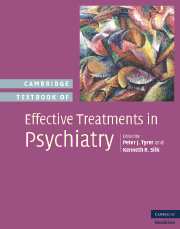Book contents
- Frontmatter
- Contents
- List of contributors
- Preface
- Part I Introduction
- Part II Summary of treatment modalities in psychiatric disorders
- 3 A critical assessment of methods and processes used to develop psychiatric drug treatments
- 4 Section I – The efficacy and safety of electroconvulsive therapy
- 4 Section II – Focal brain stimulation approaches to psychiatric treatment
- 5 The effectiveness of psychological treatments in psychiatry
- 6 Educational interventions
- 7 Complementary and alternative medicine
- 8 Complex interventions
- Part III Specific treatments
- Appendix I Summary of specific drugs having evidence of effectiveness in mental disorders
- Appendix II Key to effectiveness tables
- Index
- References
4 - Section I – The efficacy and safety of electroconvulsive therapy
from Part II - Summary of treatment modalities in psychiatric disorders
Published online by Cambridge University Press: 12 May 2010
- Frontmatter
- Contents
- List of contributors
- Preface
- Part I Introduction
- Part II Summary of treatment modalities in psychiatric disorders
- 3 A critical assessment of methods and processes used to develop psychiatric drug treatments
- 4 Section I – The efficacy and safety of electroconvulsive therapy
- 4 Section II – Focal brain stimulation approaches to psychiatric treatment
- 5 The effectiveness of psychological treatments in psychiatry
- 6 Educational interventions
- 7 Complementary and alternative medicine
- 8 Complex interventions
- Part III Specific treatments
- Appendix I Summary of specific drugs having evidence of effectiveness in mental disorders
- Appendix II Key to effectiveness tables
- Index
- References
Summary
Editor's note
Electroconvulsive therapy has the longest track record of a successful treatment in psychiatry and it would be unwise to cast it aside. Maixner and Taylor do the opposite. They are enthusiasts for the treatment and feel it is significantly underused. They give most attention to bilateral ECT and in terms of efficacy there is no doubt that this is more effective than unilateral treatment despite the advantages unilateral treatment has for likely cognitive disturbance. For more severe forms of depression bilateral ECT has definite advantages and it is in this group, both in general and old age psychiatry, that it is most widely recommended. Other disorders, apart from catatonia and neuroleptic malignant syndrome, have a much lower evidence base for treatment. Electroconvulsive treatment in the future is likely to come under threat from other newer physical treatments involving magnetic manipulations (see Chapter 4, Part II) and many more comparisons are needed between ECT and these new treatments to determine the therapeutic place of each. This chapter does not have a UK author; the differences between UK and Europe and the USA are not great, but a comparison can be made by reading.
Introduction
Electroconvulsive therapy (ECT) is the oldest continuous medical treatment for psychiatric disease. When introduced in 1938 it achieved remissions that were considered miraculous in patients who had been ill in mental hospitals for years (Endler, 1988). (Also see pp. 27–31.) As with all successful treatments it was eventually used beyond its understood indications.
- Type
- Chapter
- Information
- Cambridge Textbook of Effective Treatments in Psychiatry , pp. 57 - 82Publisher: Cambridge University PressPrint publication year: 2008

